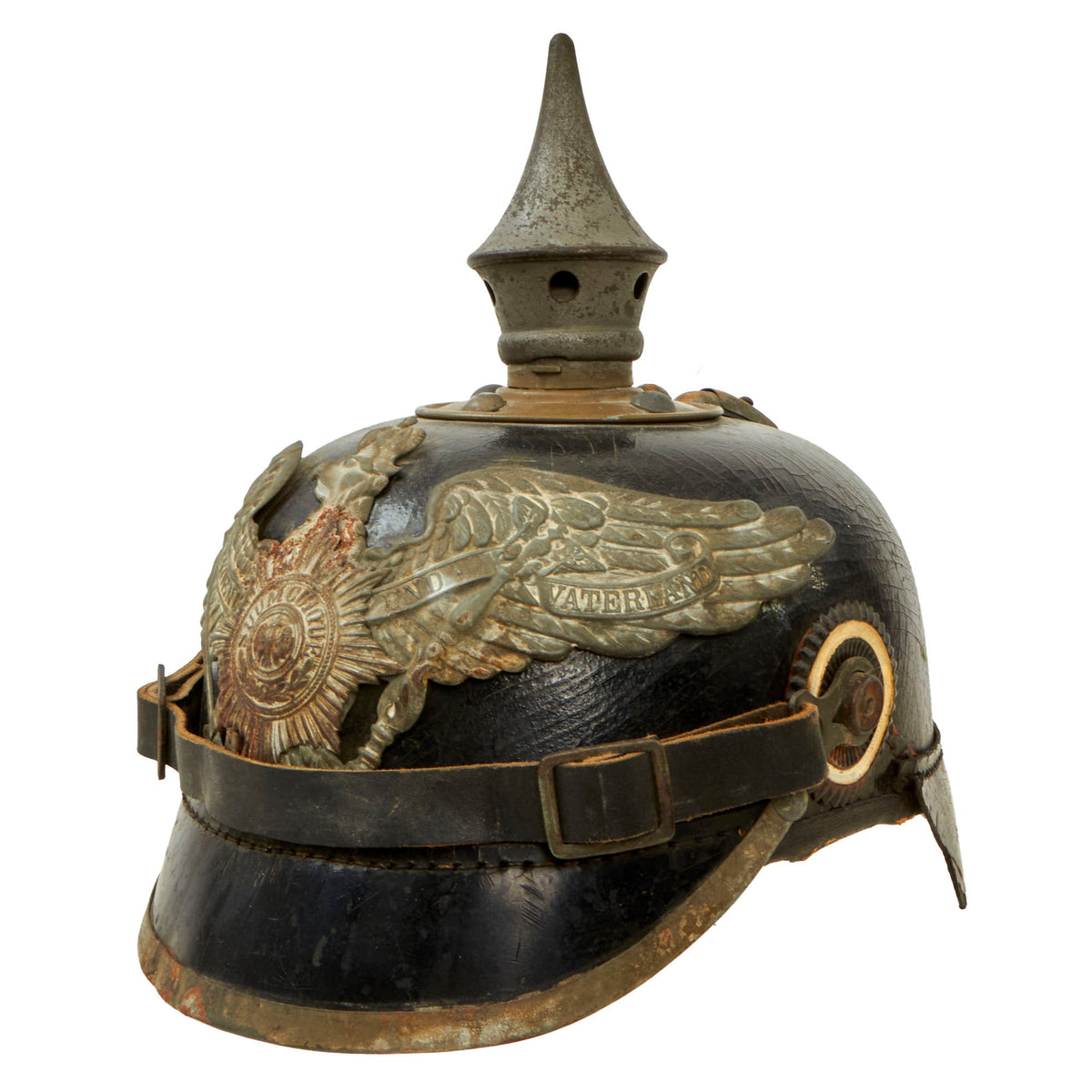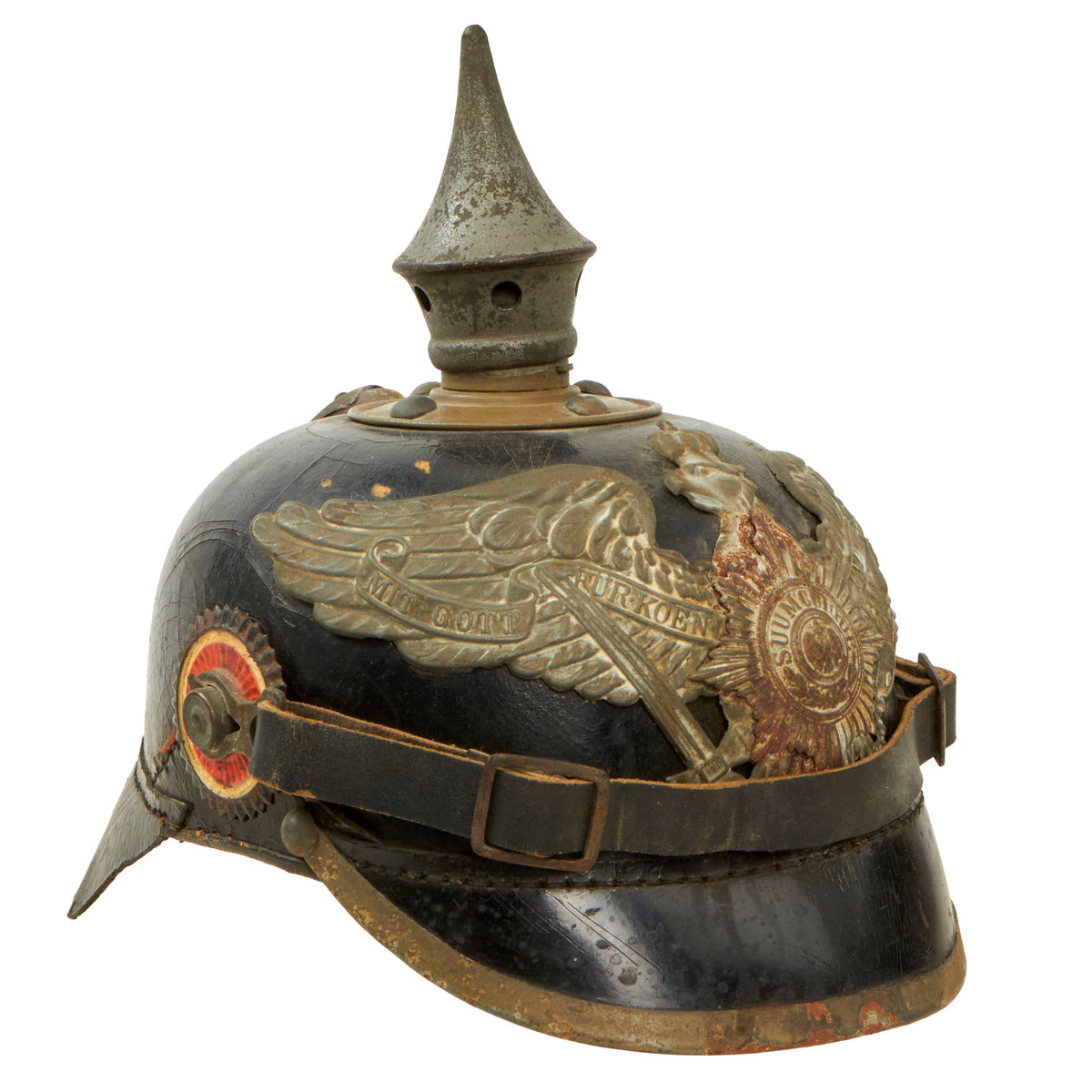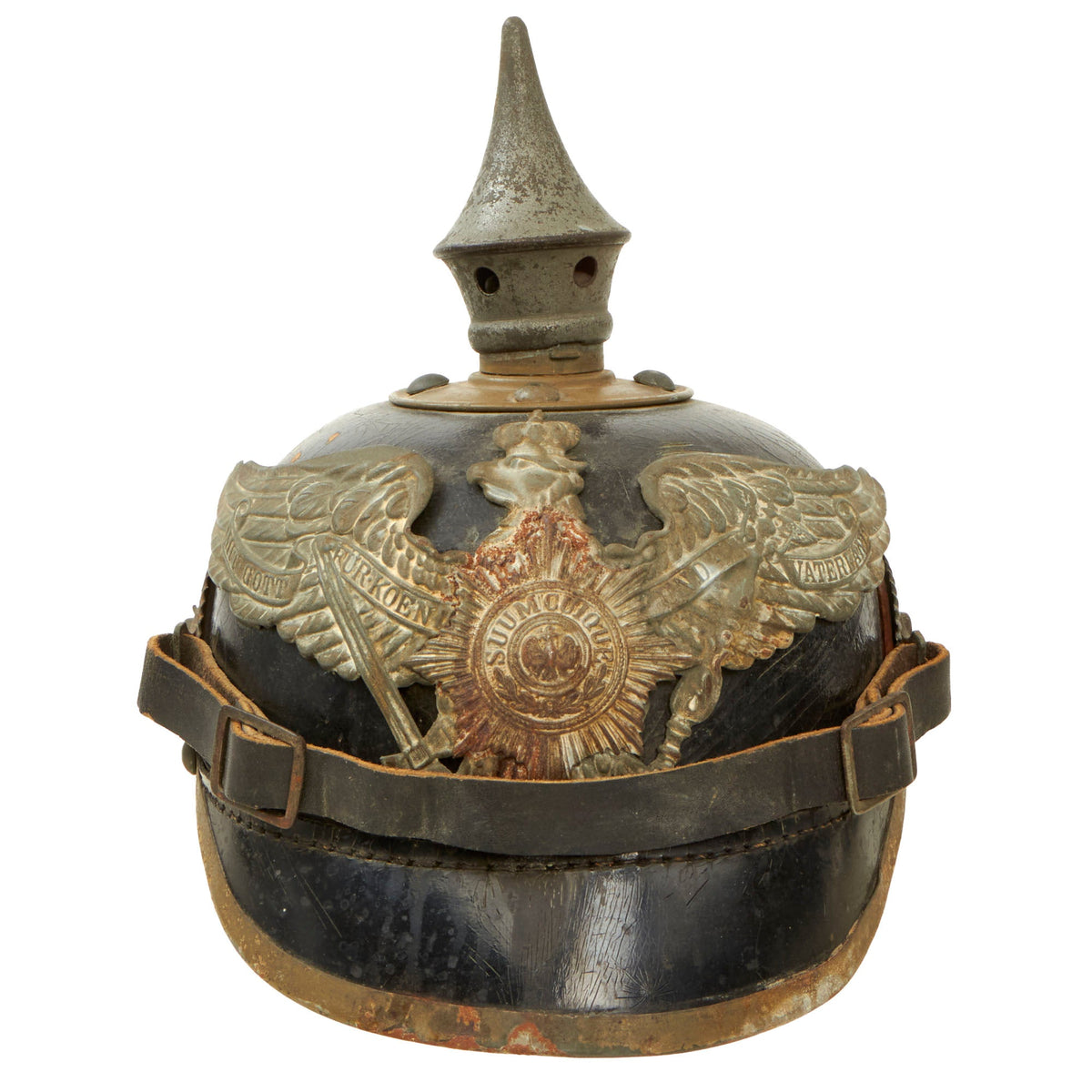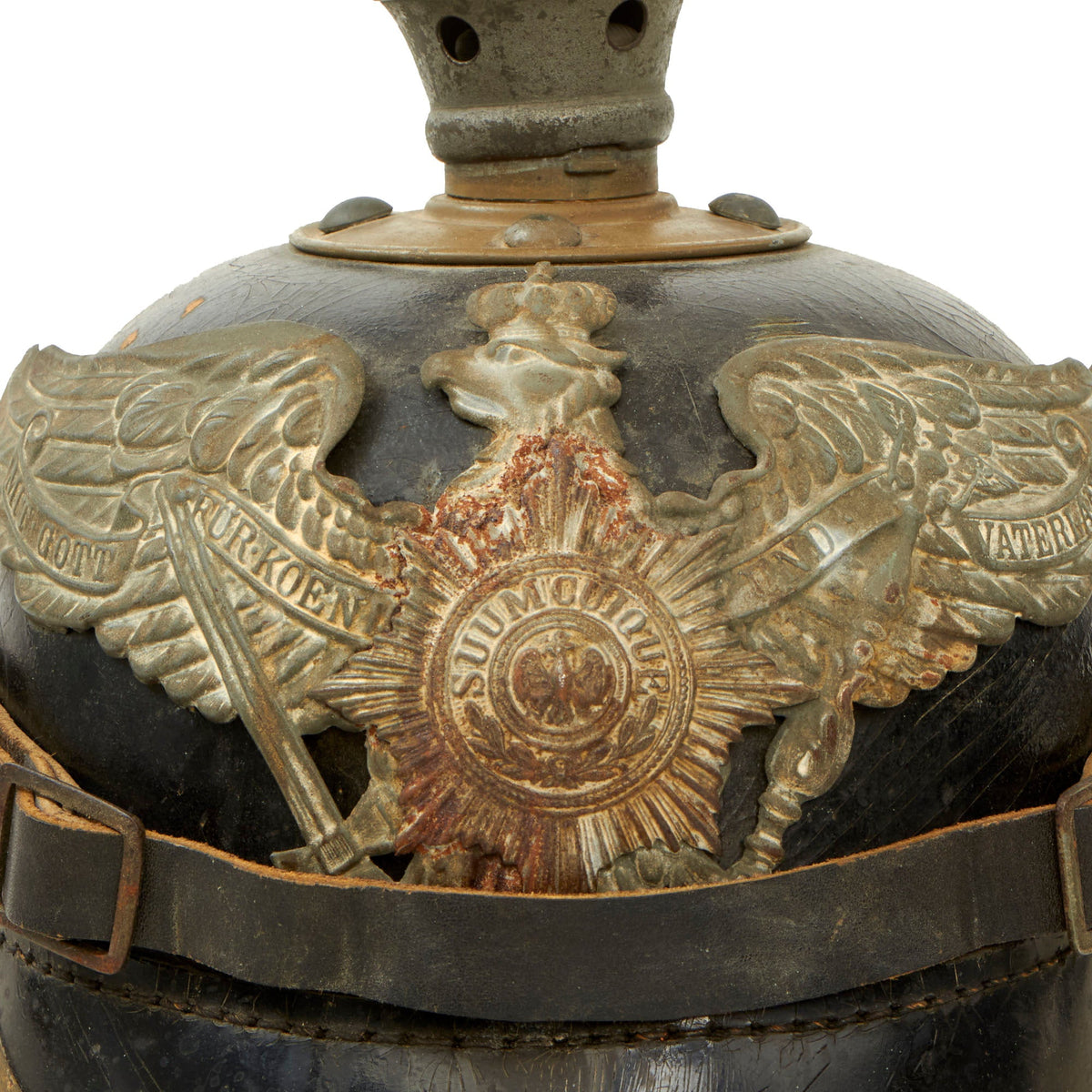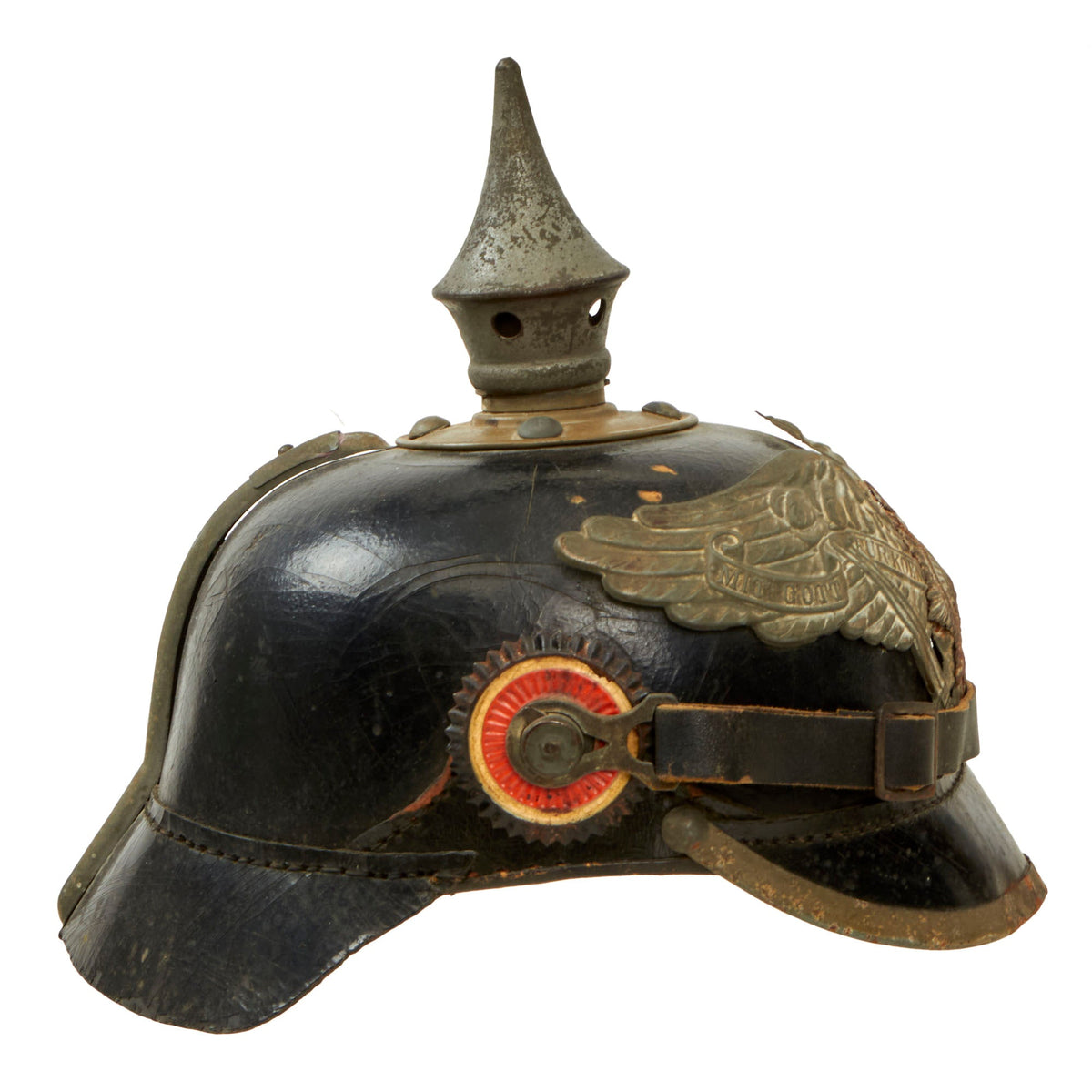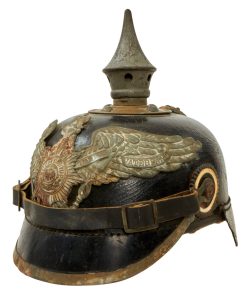Original German Prussian M1915 Garde Infantry EM-NCO Pickelhaube Helmet Original Items
$ 595,00 $ 178,50
Original Item: Only One Available. This is a very good condition Imperial German line Infantry enlisted man’s Mannschaften (other ranks) pickelhaube, with Grand Duchy of Baden (Großherzogtum Baden) Wappen and Cockades. The M1915 was the last model of Pickelhaube issued prior to the move to all steel helmets. In accordance with the 1915 regulations these helmets would no longer would use brass, silver, or Tombak as the M1895 did. All issued Pickelhaube would now use grey oxidized steel fittings for all Regiments.
The front garde korps wappen features a crowned Prussian state eagle clutching a scepter and sword in its claws, over the King’s motto, MIT GOTT FÜR KOENIG UND VATERLAND (With God for King and Country, i.e. Prussia). As this is a Garde helmet, there is a large 8 pointed “German Silver” star in the middle, which is the emblem of the Hoher Orden vom Schwarzen Adler (Order of the Black Eagle). The motto SUUM CUIQUE (to each his own) is marked above an eagle, with laurel leaves below. The Wappen is held in place by leather tabs on the back.
The crown of this leather helmet displays a vented enlisted removable spike mount on an oxidized steel baseplate. The spike is in good condition, and is easily removable using the “bayonet-style” attaching system but is unable to be placed back on with ease. It should be noted that the pieces of leather that attach the wappen to the helmet are still used, and intact.
It also has the correct “vent” on the rear support spine of the helmet. It is complete with the Baden (Yellow and Red) and German National Colors (red white and black) cockades around the chin strap lugs. In 1897 the new Reichs-Kokarde in Red-White-Black was introduced for all ranks to commemorate the 100th anniversary of the birth of Kaiser Wilhelm 1st. The Reichs-Kokarde was to be worn on the right side of the helmet, and the state Kokarde was moved to the left, as on this helmet.
The black leather shell shows normal age crazing and wear. The lacquer finished leather is in very good condition having no serious issues. All metal pieces are in place, and show no signs of ever having been removed, added, or so on. The front leather visor has oxidized steel trim in very good condition but it loose, as is the visor itself. The metal spine that descends from the spike’s baseplate to the edge of the rear visor is also in very good condition. Both of the visors are unfortunately partially detached.
Overall a very nice condition Imperial German pickelhaube from the Grand Duchy of Baden, a great addition to any collection!
Germany’s Pickelhaube helmet, distinguished by a lone spike jutting straight from its top, became a symbol of Prussian militarism in the early 20th century. At first glance, the distinctive spike seems to have served no practical purpose and use of these helmets on the battlefield was abolished during World War I.
Introduced by the Prussian military in 1843, the Pickelhaube was originally proposed for use by cavalry troops. The helmets, made of pressed leather, were developed as an updated solution to the conical shako hats worn by Prussians during the Napoleonic Wars.
Napoleonic-era shakos offered virtually no head protection and were cumbersome to wear in wet conditions, as they easily soaked up rain. The Pickelhaube, therefore, was greeted as a practical modern invention. The new “leather helmets” or “helmets with spikes” gave soldiers’ greater head covering and visibility.
The distinctive spike on the Pickelhaube was supposed to function as a blade tip. It was designed to deflect sword blows aimed at the head. The spikes could be modified depending on soldiers’ battlefield duties and outfitted with plumes on formal occasions.
Use of the helmet became widespread throughout Germany and was even adopted by regional police forces and fire brigades. The helmet was often greeted with sarcasm and mockery, even within Germany. In 1843, the famous German poet, Heinrich Heine, wrote and published a satiric poem, “Germany: A Winter’s Tale,” in the poem, Heine compared the Pickelhaube to a lightning rod:
“Yes, yes, I like the helmet, it demonstrates the loftiest wit!
A kingly inspiration, it was! Complete with a point and tip!
I’m just afraid a storm will come and only too easily hit,
That romantic crown of yours with a fancy lightning blitz!”
The Pickelhaube became a symbol of Prussian aggressiveness and battle prowess. An imperial proclamation in 1871 made the Pickelhaube mandatory for all German troops.
Proud Prussian military leaders with bristling mustaches posed for publicity photos sporting the Pickelhaube, including Kaiser Wilhelm II, Otto von Bismarck, and Paul von Hindenburg. In other countries, the horned helmets became synonymous with barbarism, especially during World War I.
Fast Shipping with Professional Packaging
Thanks to our longstanding association with UPS FedEx DHL, and other major international carriers, we are able to provide a range of shipping options. Our warehouse staff is expertly trained and will wrap your products according to our exact and precise specifications. Prior to shipping, your goods will be thoroughly examined and securely secured. We ship to thousands clients each day across multiple countries. This shows how we're dedicated to be the largest retailer on the internet. Warehouses and distribution centres can be located throughout Europe as well as the USA.
Note: Orders with more than one item will be assigned a processing date depending on the item.
Before shipping before shipping, we'll conduct a thorough inspection of the items you have ordered. Today, the majority of orders will be delivered within 48 hours. The delivery time will be between 3-7 days.
Returns
The stock is dynamic and we cannot completely manage it because multiple stakeholders are involved, including our factory and warehouse. So the actual stock may alter at any time. It's possible that you may not receive your order once the order has been made.
Our policy is valid for a period of 30 days. If you don't receive the product within 30 days, we are not able to issue a refund or an exchange.
You can only return an item if it is unused and in the same state as the day you received it. You must have the item in its original packaging.
Related products
Uncategorized
Uncategorized
Uncategorized
Uncategorized
Uncategorized
Uncategorized
Uncategorized
Uncategorized
Angolan Rebel 1970s era 60mm Inert Display Mortar from Angolan Civil War Original Items
Uncategorized
Uncategorized
Armored Burgonet Helmet & Polearm from Scottish Castle Leith Hall Circa 1700 Original Items
Uncategorized
Uncategorized
Uncategorized
Uncategorized
Uncategorized
Uncategorized
Armoured Fighting Vehicles of the World: AFVs of World War One (Hardcover Book) New Made Items
Uncategorized
Uncategorized
Uncategorized
